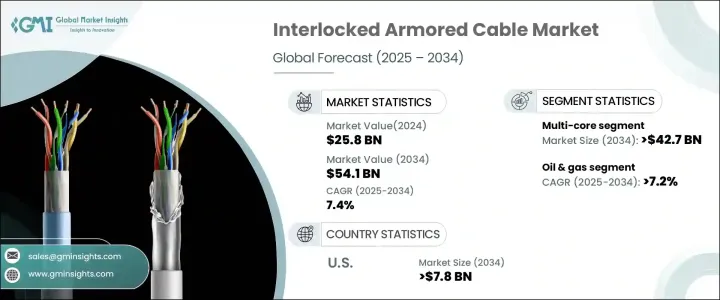
세계의 인터락 외장 케이블 시장은 2024년에 258억 달러로 평가되었고 2025년부터 2034년에 걸쳐 CAGR 7.4%를 나타내 강력한 성장이 전망되고 있습니다.
이 시장은 주로 산업, 상업, 주택의 각 분야에서 내구성이 뛰어난 고성능 전기 솔루션에 대한 수요가 높아지고 있는 것이 배경에 있습니다. 우수한 내구성과 기계적 손상에 대한 내성으로 알려진 인터락 외장 케이블은 배전, 자동화, 데이터센터 등 보호 강화가 필요한 용도에서 인기를 끌고 있습니다. 신흥 경제 국가에서는 급속한 도시화와 대규모 인프라 개발이 결합되어 안정적이고 안전한 전기 시스템에 대한 수요가 증가하고 있습니다. 이러한 케이블은 탄력성과 안전성을 양보할 수 없는 환경에서 점점 더 선호되고 있으며 시장 성장을 더욱 촉진하고 있습니다. 또한 스마트 인프라와 신재생에너지 프로젝트의 확대로 현대의 전기 시스템에 필수적인 구성 요소로서 인터락 외장 케이블의 중요성이 높아지고 있습니다.

에너지 효율과 안전 기준이 중시되고 있기 때문에 석유 및 가스, 광업, 화학 등의 리스크가 높은 산업에서 외장 케이블의 채용이 진행되고 있습니다. 이 산업은 극단적인 온도, 부식성 환경, 물리적 충격과 같은 가혹한 조건을 견디는 인터락 외장 케이블에 크게 의존합니다. 또한 케이블 제조 기술의 진보로 보다 가볍고 유연한 제품이 탄생하여 설치가 간소화되어 사용성이 향상되었습니다. 중요한 인프라 프로젝트에서 외장 케이블의 사용을 촉진하는 정부 규정은 이러한 동향을 더욱 보완하고 재생 가능 에너지 장비, 산업 자동화 및 대규모 인프라 개발에 이러한 케이블이 필수적입니다.
| 시장 범위 | |
|---|---|
| 시작 연도 | 2024년 |
| 예측 연도 | 2025-2034년 |
| 시작 금액 | 258억 달러 |
| 예측 금액 | 541억 달러 |
| CAGR | 7.4% |
2034년까지 427억 달러를 창출할 것으로 예측되는 멀티코어 분야가 시장을 독점합니다. 멀티코어 외장 케이블은 다용도가 높고 여러 개의 전기 회로를 하나의 피복 안에 담을 수 있습니다. 이 기능은 설치 복잡성을 최소화하고 전반적인 비용을 절감하기 때문에 이러한 케이블은 산업 자동화, 데이터센터 및 스마트 인프라 프로젝트에 자주 사용됩니다. 신재생에너지·시스템과 채굴 작업 등 엄격한 조건 하에서의 뛰어난 내구성과 성능은 고성능 용도에서의 지속적인 채용을 확실히 하고 있습니다.
석유 및 가스 산업은 2034년까지 연평균 복합 성장률(CAGR) 7.2%를 나타내 주요 촉진요인으로 대두할 것으로 예측됩니다. 이 수요는 업계가 까다로운 위험한 환경에서도 작동할 수 있는 견고하고 신뢰할 수 있는 전기 솔루션에 의존하고 있기 때문입니다. 인터락 외장 케이블은 기계적 손상과 부식에 대한 뛰어난 내성을 갖추고 있기 때문에 해상 플랫폼, 드릴링 현장 및 기타 산업 시설에서 작업 효율을 보장하는 데 필수적입니다.
북미의 인터락 외장 케이블 시장은 2034년까지 78억 달러에 달할 것으로 예측됩니다. 인프라 확장, 신재생에너지 설치, 스마트 그리드 및 데이터센터 채택 확대가 이 지역 수요를 견인하고 있습니다. 케이블의 비교할 수 없는 내구성과 가혹한 조건하에서의 성능에 의해 석유 및 가스, 광업, 화학 처리 등의 산업에서 불가결한 것이 되고 있습니다.
The Global Interlocked Armored Cable Market, valued at USD 25.8 billion in 2024, is anticipated to experience robust growth at a CAGR of 7.4% between 2025 and 2034. The market is primarily driven by the rising demand for durable, high-performance electrical solutions across industrial, commercial, and residential sectors. Known for their exceptional durability and resistance to mechanical damage, interlocked armored cables are gaining traction in applications that require enhanced protection, such as power distribution, automation, and data centers. Rapid urbanization, coupled with extensive infrastructure development in emerging economies, is fueling the demand for reliable and secure electrical systems. These cables are increasingly favored in environments where resilience and safety are non-negotiable, further propelling market growth. Additionally, the expansion of smart infrastructure and renewable energy projects underscores the growing importance of interlocked armored cables as essential components of modern electrical systems.

A significant focus on energy efficiency and safety standards is boosting the adoption of armored cables in high-risk industries, including oil and gas, mining, and chemicals. These industries rely heavily on interlocked armored cables for their ability to withstand harsh conditions, such as extreme temperatures, corrosive environments, and physical impacts. Advancements in cable manufacturing technology have also resulted in lighter, more flexible products that simplify installation and enhance usability. Government regulations promoting the use of armored cables in critical infrastructure projects further complement these trends, making these cables indispensable in renewable energy installations, industrial automation, and large-scale infrastructure developments.
| Market Scope | |
|---|---|
| Start Year | 2024 |
| Forecast Year | 2025-2034 |
| Start Value | $25.8 Billion |
| Forecast Value | $54.1 Billion |
| CAGR | 7.4% |
The multi-core segment is poised to dominate the market, projected to generate USD 42.7 billion by 2034. Multi-core armored cables are highly versatile, enabling multiple electrical circuits to be housed within a single sheath. This feature minimizes installation complexity and reduces overall costs, making these cables a popular choice for industrial automation, data centers, and smart infrastructure projects. Their superior durability and performance under demanding conditions, including renewable energy systems and mining operations, ensure their continued adoption across high-performance applications.
The oil and gas industry is set to emerge as a key growth driver, with a CAGR of 7.2% through 2034. This demand stems from the sector's reliance on robust and reliable electrical solutions capable of operating in challenging and hazardous environments. Interlocked armored cables are essential for ensuring operational efficiency on offshore platforms, drilling sites, and other industrial facilities, as they provide exceptional resistance to mechanical damage and corrosion.
In North America, the interlocked armored cable market is projected to reach USD 7.8 billion by 2034. Infrastructure expansion, renewable energy installations, and the growing adoption of smart grids and data centers are driving demand in the region. The cables' unmatched durability and ability to perform in extreme conditions make them indispensable for industries like oil and gas, mining, and chemical processing.